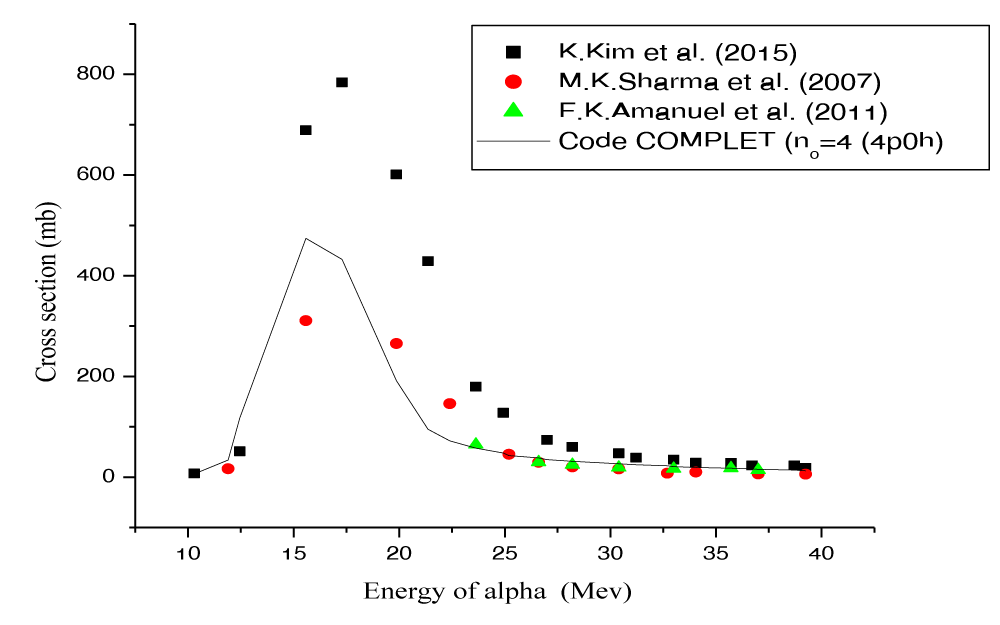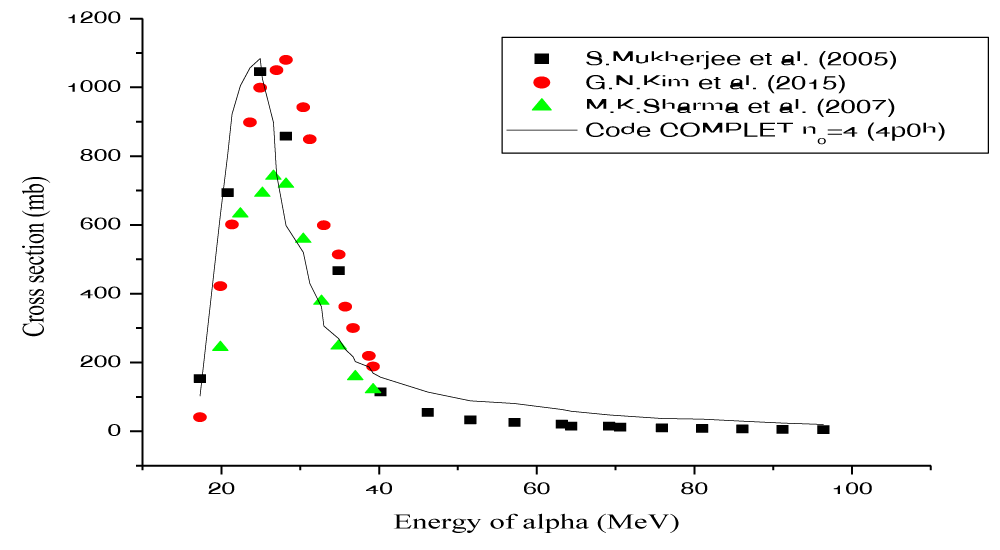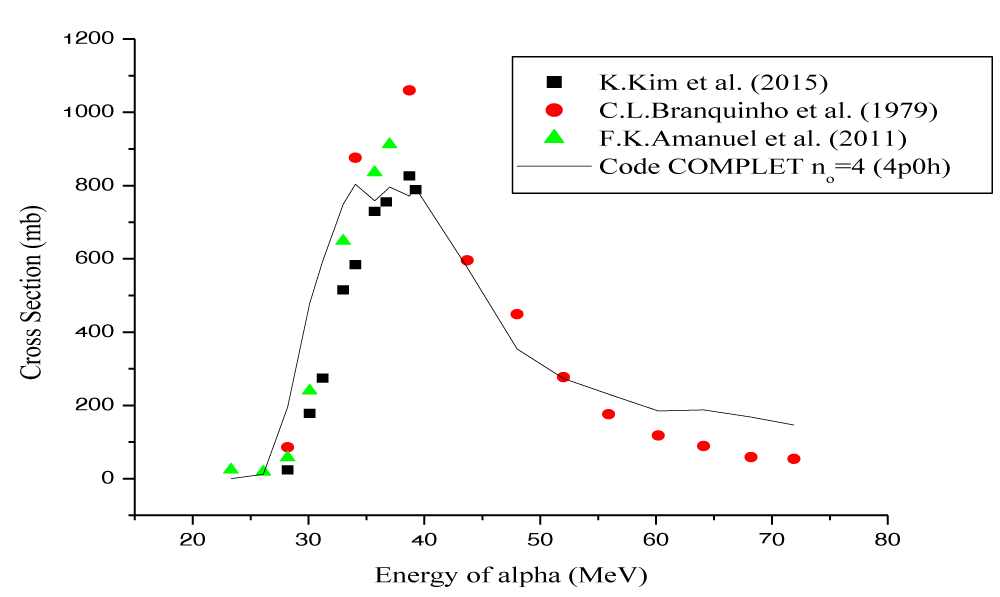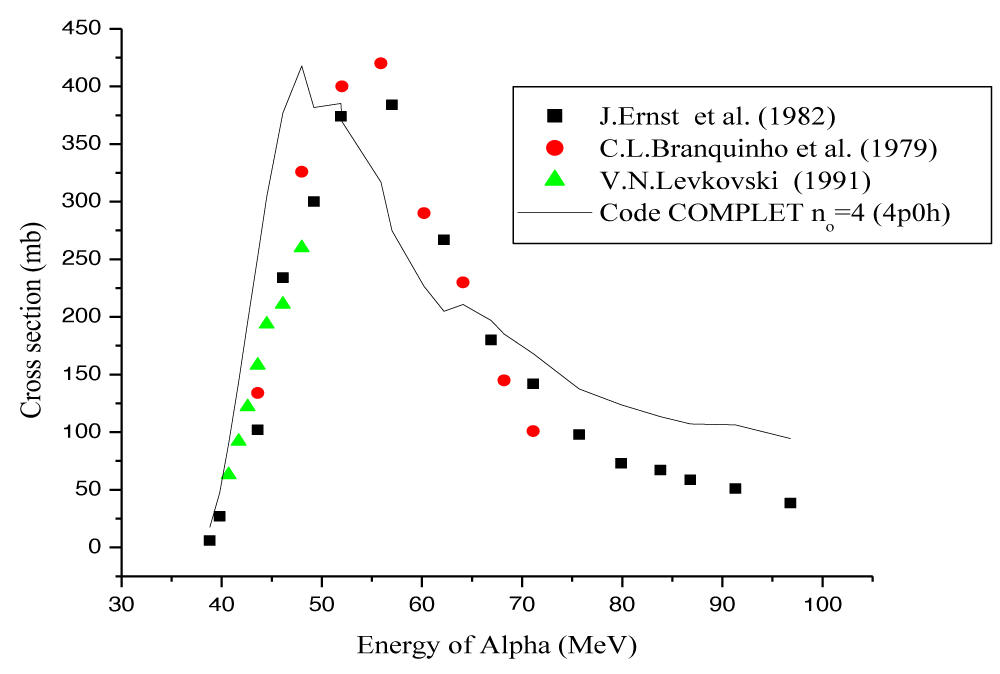More Information
Submitted: February 21, 2023 | Approved: October 03, 2023 | Published: October 04, 2023
How to cite this article: Mekonen CS, Mekonen TA. Pre-equilibrium Effects on Alpha Particle Induced Reactions on Niobium Isotope from Threshold upto 100mev using the Computer Code COMPLET. Int J Phys Res Appl. 2023; 6: 180-184.
DOI: 10.29328/journal.ijpra.1001069
Copyright License: © 2023 Mekonen CS, et al. This is an open access article distributed under the Creative Commons Attribution License, which permits unrestricted use, distribution, and reproduction in any medium, provided the original work is properly cited.
Keywords: Alpha particles; Induced reactions; Niobium- 93 isotopes; COMPLET
Pre-equilibrium Effects on Alpha Particle Induced Reactions on Niobium Isotope from Threshold upto 100MeV using the Computer Code COMPLET
Cherie Sisay Mekonen1,2* and Teshagre Aklie Mekonen2
1Department of Physics, College of Natural and Computational Science, Woldia University, Woldia, Ethiopia
2Department of Physics, College of Natural and Computational Science, University of Gondar, Gondar, Ethiopia
*Address for Correspondence: Cherie Sisay Mekonen, Department of Physics, College of Natural and Computational Science, Woldia University Woldia, Ethiopia, Email: [email protected]
Excitation functions (EF) for four reactions of the type 93Nb (α, xn); x = 1-4 were studied. This study provides current evidences about the dominance of pre-equilibrium processes at high energies followed by compound nucleus equilibration at low energies. The main objective of the work is to look pre-equilibrium emission induced by alpha particle energies up to 100 MeV on Niobium through describing, analyzing and interpreting the theoretical results of cross sections obtained from computer code COMPLET by comparing with experimental data obtained from EXFOR library. COMPLET code has been used for the analysis using the initial exciton number n0 = 4(4p+oh) and level density parameter ACN/10. A general agreement was found for all reactions.
Nuclear reactions induced by alpha particle in the energy region 20 MeV - 200 MeV are interesting since last few decades in view of the associated pre-equilibrium processes at high energies followed by compound nucleus at low energies. This smooth variations of cross sections as the equilibrating target-projectile system proceeds towards equilibration is an interesting study as the shape of excitation function reveals the reaction mechanisms [1-3]. In order to explain the nuclear equilibration several semi classical modals were proposed during the past decades [4-6]. This reaction modals were constantly revised and refined and very important when the experimental data are not available. The basic idea of these modals is that the projectile-target system is attributed by a very few degrees of freedom in the initial phase of interaction and successively passes through a series of stages of equilibration and eventually reaches the state of equilibrium which is characterized by a large number of degrees of freedom [7-10].
In this paper we have studied the excitation functions of four reactions of the type 93Nb (α, xn); x = 1-4; bombard with alpha particle upto 100 MeV. The high energy tails of (α, xn) excitation functions provide a good basis to examine the pre-equilibrium modals in details. The experimental data is obtained from EXFOR library, IAEA [11,12].
Computer code COMPLET
The computer code COMPLET is a nuclear reaction code which was developed to generate theoretical data on nuclear reactions. Code COMPLET has been essentially developed to analyze the nuclear reaction mechanisms. The code COMPLET allows the evaporation of proton, neutron, deuterium and alpha particles, triton and Helium-3 [13-15]. This code is an improved version of earlier computer codes and is very important for several technical applications if the experimental data is not available or unable to measure the reaction cross-sections due to experimental difficulties. This code is a capable of calculating equilibrium and pre-equilibrium emission presses upto 300 MeV.
Comparison of theoretical result and experimental values
To compare the theoretical and experimental cross-section results, the researchers use Pearson’s correlation coefficient (R).
(1)
Where, R-is correlation coefficient, <Xt> and <Xei> represent the mean theoretical and experimental cross-sections respectively, Xti and Xeii are the theoretical and experimental cross-sections of the ith value respectively, N is number of the theoretical and experimental data where as SXt and SXe are the standard deviation of the theoretical and experimental cross-sections respectively. Each mentioned variable represents the following mathematical relations:
The value of R is in between -1 and 1. Where, 1 is the total positive linear correlation, 0 is no linear correlation, and −1 is total negative linear correlation. If 0 < R < 0.3, the correlation is weak and positive, if 0.3 ≤ R < 0.7, it describes moderate correlation and for 0.7 ≤ R < 1, the correlation is strong and positive. The results for each data in this thesis have been calculated by using Pearson’s correlation coefficient calculator (statistics calculator).
The computed cross-sections induced by alpha particle on niobium isotope are listed in Tables 1-4 along with experimental cross-sections [15-21] are plotted with total cross-section against the projectile energies. The level density parameters , the initial exciton number no = 4(4p+0h) has been taken for α-particles, as best fit for all reactions.
| Table 1: Theoretical and experimental cross section for 93Nb (a,n) 96Tc reactions. | ||||
| Reaction Cross section (mb) | Experimental cross section 93Nb (a, n) | Theoretical cross section (mb) | ||
| Ea (Mev) | K Kim, et al. [16] | MK, Sharma. et al. [17] | FK, Amanuel, et al. [18] | |
| 10.26 | 7.3±0.4 | - | - | 6.45 |
| 11.9 | - | 16.9±2 | - | 34.09 |
| 12.45 | 51.4±2.6 | - | - | 117.4 |
| 15.58 | 689±34.5 | 310.8±1 | - | 474.2 |
| 17.29 | 784±39.2 | - | - | 432.6 |
| 19.87 | 601±30.1 | 265.4±2.3 | - | 191.6 |
| 21.36 | 429±21.5 | - | - | 95.31 |
| 22.4 | - | 146.1±5.9 | - | 72.3 |
| 23.63 | 180±9.1 | - | 64.7 | 57.78 |
| 24.93 | 128±6.4 | - | - | 48.16 |
| 25.2 | - | 45.5±1.9 | - | 42.8 |
| 26.6 | - | 29.5±2.7 | 30 | 38.26 |
| 27 | 74.2±3.8 | - | - | 34.9 |
| 28.2 | 60.2±3.1 | 20.5±1.6 | 24.5 | 31.6 |
| 30.4 | 47.6±2.4 | 16.6±3.1 | 19.2 | 26.7 |
| 31.22 | 38.8±2 | - | - | 24.78 |
| 32.7 | - | 8±1.5 | 22.66 | |
| 33 | 34.8±1.8 | - | 16.7 | 21.12 |
| 34.05 | 28.6±1.5 | 10.3±1.5 | - | 19.47 |
| 35.71 | 28.5±1.5 | - | 17.9 | 17.91 |
| 36.71 | 23.2±1.2 | - | - | 16.58 |
| 37 | - | 6.5±1 | 14.3 | 15.53 |
| 38.71 | 23.2±1.2 | - | - | 14.15 |
| 39.25 | 18.3±1 | 5.9±0.7 | - | 12.95 |
| Table 2: Theoretical and experimental cross section for 93Nb (a, 2n) 96Tc reactions. | ||||
| Reaction Cross section (mb) | Experimental cross section 93Nb (a, 2n) | Theoretical cross section (mb) | ||
| Ea (Mev) | S Mukherjee, et al. | GN Kim, et al. | MK Sharma, et al. | |
| 17.3 | 153±14.3 | 40.7±2.3 | - | 102.4 |
| 19.87 | - | 422±21.1 | 244±2.7 | 630.1 |
| 20.8 | 694±61.8 | - | - | 804.1 |
| 21.36 | - | 601±30.2 | - | 922.1 |
| 22.4 | - | 632.1±2.6 | 1005 | |
| 23.63 | - | 898±24.9 | - | 1057 |
| 24.93 | 1046±95.7 | 999±50.1 | - | 1084 |
| 25.2 | - | - | 692.1±6.4 | 1025 |
| 26.6 | - | - | 741.5±6.8 | 897.5 |
| 27 | - | 1050±52.4 | - | 747 |
| 28.2 | 858±50.3 | 1080±54 | 718.7±6.3 | 598.3 |
| 30.4 | - | 942±42.1 | 558.3±4.4 | 520.1 |
| 31.22 | - | 849±42.6 | - | 429.2 |
| 32.7 | - | - | 378.2±2.7 | 361.9 |
| 33 | - | 599±30 | - | 305.9 |
| 34.9 | 467±28.1 | 514±24.8 | 247.9±2.3 | 269.2 |
| 35.71 | - | 362±18.1 | - | 238.2 |
| 36.71 | - | 300±15.1 | - | 216.7 |
| 37 | - | - | 159.1±1.9 | 202.4 |
| 38.71 | - | 219±11 | - | 186.9 |
| 39.25 | - | 188±9.5 | 121±1.9 | 169 |
| 40.2 | 114.25±7.02 | - | - | 157 |
| 46.2 | 54.55±3.02 | - | - | 114 |
| 51.6 | 33.01±1.92 | - | - | 88.43 |
| 57.2 | 25.61±1.51 | - | - | 80.47 |
| 63.2 | 20.47±1.01 | - | - | 63.3 |
| 64.4 | 15±0.9 | - | - | 58.24 |
| 69.2 | 14.76±0.81 | - | - | 47.35 |
| 70.6 | 12±0.7 | - | - | 45.23 |
| 75.9 | 9.7±0.6 | - | - | 37.02 |
| 81 | 7.76±0.6 | 35.37 | ||
| 86.1 | 6.33±0.43 | - | - | 29.34 |
| 91.2 | 5.28±0.37 | - | - | 23.85 |
| 96.4 | 4.4±0.33 | - | - | 19.79 |
| Table 3: Theoretical and experimental cross section for 93Nb (a, 3n) 94Tc reactions. | ||||
| Reaction Cross section (mb) | Experimental cross section 93Nb (a, 3n) | Theoretical cross section (mb) | ||
| Ea (Mev) | K. Kim et al. | CL. Branquinho et al. | FK. Amanuel et al. | |
| 23.3 | - | - | 24.2 | 0.00 |
| 26.1 | - | - | 18.5 | 11.98 |
| 28.2 | 23.9±1.2 | 86 | 57.7 | 195.7 |
| 30.1 | 178.2±10.7 | - | 239.9 | 478.8 |
| 31.22 | 274.2±15.8 | - | - | 594 |
| 33 | 515.3±26.1 | - | 649 | 749.2 |
| 34.05 | 584.3±31.3 | 876 | - | 803.6 |
| 35.71 | 729.2±39.7 | - | 835.9 | 758.4 |
| 36.71 | 755.6±41.3 | - | 786.9 | |
| 37 | - | - | 912.3 | 796.3 |
| 38.71 | 826.3±45.2 | 1060 | - | 771.4 |
| 39.25 | 788.9±43.8 | - | - | 793.3 |
| 43.7 | - | 596 | - | 576.2 |
| 48 | - | 449 | - | 354 |
| 52 | - | 277 | - | 273.4 |
| 55.9 | - | 176 | - | 230.7 |
| 60.2 | - | 118 | - | 184.7 |
| 64.1 | - | 89 | - | 187.9 |
| 68.2 | - | 59 | - | 168.3 |
| 71.9 | - | 54 | - | 146.3 |
| Table 4: Theoretical and experimental cross section for 93Nb (a, 4n) 93Tc reactions. | ||||
| Reaction Cross section (mb) | Experimental cross section 93Nb (a, 4n) | Theoretical cross section (mb) | ||
| Ea (Mev) | J. Ernst, et al. | CL Branquinho, et al. | VN. Levkovski | |
| 38.8 | 6 | - | - | 17.4 |
| 39.8 | 27 | - | - | 47.23 |
| 40.7 | - | - | 63 | 89.95 |
| 41.7 | - | - | 92 | 143.8 |
| 42.6 | - | - | 122 | 196.1 |
| 43.6 | 102 | 134 | 158 | 252.5 |
| 44.5 | - | 193 | 304.4 | |
| 46.1 | 234 | - | 211 | 377 |
| 48 | - | 326 | 260 | 417.8 |
| 49.2 | 300 | - | - | 381.7 |
| 51.9 | 374 | - | - | 385.2 |
| 52 | - | 400 | - | 369.5 |
| 55.9 | - | 420 | - | 317.1 |
| 57 | 384 | - | - | 274.8 |
| 60.2 | - | - | - | 226.5 |
| 62.2 | 267 | 290 | - | 204.9 |
| 64.1 | - | - | - | 210.8 |
| 66.9 | 180 | 230 | - | 196.9 |
| 68.2 | - | - | - | 185.1 |
| 71.1 | 142 | 145 | - | 168.2 |
| 75.7 | 98 | 101 | - | 137.5 |
| 79.9 | 73 | - | - | 123.7 |
| 83.8 | 67 | - | - | 113.5 |
| 86.8 | 58.7 | - | - | 107.2 |
| 91.3 | 51 | - | - | 106.4 |
| 96.8 | 38.5 | - | - | 94.49 |
Comparison of theory
The experimental values by different authors [16-22], are compared with theoretical predications by the code COMPLET.
In the pre-equilibrium part the calculation starts with the initial exciton number no = 4(4p+0h) for α-particles as projectile, that means the particles above and holes below the fermi sea during the initial stages of interaction. It proceeds quickly to the states with increasing exciton number. For each state, the emission probability is calculated and finally the integrated yield the cross sections for individual reactions. The mean free path multiplier was kept for all the competitions. The level density parameters was used globally. The crucial parameter in the calculation is initial exciton number no (i.e. particle above and hole below fermi sea). A general recommendation for the initial exciton number varies between Ao and Ao + 2 (Ao is mass number of the projectile) for alpha particles. The reasonable choice used in the calculation is no = 4(4p+0h) as the initial configuration. In general, it is observed that in all the four reactions (4p+0h) gives good agreement with experiment.
Figures 1-4 show the excitation functions for the for the reactions 93Nb [(α, n), (α, 2n), (α, 3n), (α, 4n)] along with the theoretical predications by COMPLET code. The experimental values in all the four reactions are in better agreement with the computed cross sections by COMPLET code is pre-equilibrium dominated energy region 20 MeV - 100 MeV. As can be seen in Figures 2,4 while theoretical values give excellent agreement with all other authors of experiment, the values reported by K. Kim, et al. [16], values are systematically underestimated this could be due to the variation in experimental techniques employed in their measurements. However, there is an overall agreement between experiment and theory using initial configurations no = 4(4p+0h).
Figure 1: Comparison of theoretical and experimental cross section for 93Nb (α, n) 96Tc reactions.
Figure 2: Comparison of theoretical and experimental cross section for 93Nb (α, 2n) 95Tc reactions.
Figure 3: Comparison of theoretical and experimental cross section for 93Nb (α, 3n) 94Tc reactions.
Figure 4: Comparison of theoretical and experimental cross section for 93Nb (α, 4n) 93Tc reactions.
Excitation functions of four reactions of the type 93Nb (α, xn); x = 1-4; are studied in the present work. From an overall comparison between experimental values and theoretical predictions, one can infer that COMPLET code gives a satisfactory prediction on account of nucleons emission in the medium mass nuclei like Niobium. The initial exciton number no = 4(4p+0h) choice justifies with the basic premise of pre-equilibrium decay that only a small number of degrees of freedom are initially excited in a nuclear reaction. In short, pre-equilibrium phenomena are a few degree phenomena.
The authors are profoundly thankful to Dr. AV Mohan Rao (Associate Professor) who with his unique research competence, selfless devotion, thoughtful guidance, inspirational thoughts, wonderful patience and above all parent like directions and affections motivated them to pursue this work. The authors wish to express their gratitude to all those who contributed various ways to make this work a reality.
- Agarwal A, Rizvi IA. Excitation function studies of α induced reactions for niobium and preequilibrium effects. 2002. December 2016. https://doi.org/10.1103/PhysRevC.65.034605
- Rao AVM, Mukherjee S, Rao JR. Alpha particle induced reactions on copper and tantalum. 1991; 36(1): 115-123.
- The I. Equilibrium and Pre-Equilibrium Studies in Some Alpha Induced Reactions on Rhodium. 2001; 70(10): 2903 -2908. https://doi.org/10.1143/JPSJ.70.2903
- Blann M. Preequilibrium Decay. Annu Rev Nucl Sci. 1975; 25: 123-166. https://doi.org/10.1146/annurev.ns.25.120175.001011
- Feshbach H, Kerman A, Koonin S. The statistical theory of multi-step compound and direct reactions. Annals of Physics. 1980; 125(2): 429-476. https://doi.org/10.1016/0003-4916(80)90140-2
- Maencher H, Hensel H. Determination of Order and Deadtime for Multivariable Discrete-Time Parameter Estimation Methods. IFAC Proceedings Series. 1985; 7: 1811-1816. https://doi.org/10.1016/s1474-6670(17)60832-2
- Cline CK, Blann M. The pre-equilibrium statistical model: Description of the nuclear equilibration process and parameterization of the model. Nuclear Physics Section A. 1971; 172(2): 225–259. https://doi.org/10.1016/0375-9474(71)90713-5
- Gadioli E, Erba EG, Sona PG. Intermediate-state decay rates in the exciton model. Nuclear Physics Section A. 1973; 217(3): 589-610. https://doi.org/10.1016/0375-9474(73)90414-4
- Gadioli E, Gadioli-Erba E, Hogan JJ, Jacak BV. Model for alpha particle induced nuclear reactions: Nb93(,xypzn) from 40-140 MeV. Physical Review C. 1984; 29(1): 76–92. https://doi.org/10.1103/PhysRevC.29.76
- Griffin JJ. Statistical model of intermediate structure. Physical Review Letters. 1966; 17(9):478-481. https://doi.org/10.1103/PhysRevLett.17.478
- Dupont E, Koning AJ, Otuka N. Exploratory data analysis of the EXFOR database. Journal of the Korean Physical Society. 2011; 59(23): 1333–1336. https://doi.org/10.3938/jkps.59.1333
- Lemmel HD. Short guide to EXFOR. 1986. June. https://www-nds.iaea.org/exfor/endf.htm
- Angdasaw KA. Study of reaction mechanism in P + 133 CS systems at various energies of protons. June.
- Blann M, Vonach HK. Global test of modified precompound decay models. Physical Review C. 1983; 28(4): 1475-1492. https://doi.org/10.1103/PhysRevC.28.1475
- Kebede E. the Study of Α-Particle Induced Reactions on 27Al & 197Au Nuclides. 2014; https://pdfs.semanticscholar.org/59aa/2c73ae3a0a01c2f1433e6549f25767430b82.pdf
- Kim K, Kim GN, Naik H, Zaman M, Yang SC, Song TY, Guin R, Das SK. Excitation function and isomeric ratio of Tc-isotopes from the 93Nb(α, xn) reaction. Nuclear Physics A. 2015; 935:65–78. https://doi.org/10.1016/j.nuclphysa.2014.12.006
- Kumar Sharma M, Bhardwaj HD, Unnati P, Singh P, Singh BP, Prasad R. A study of pre-equilibrium emission of neutrons in 93Nb(α, xn) reactions. European Physical Journal A. 2007; 31(1): 43–51. https://doi.org/10.1140/epja/i2005-10318-5
- Amanuel FK, Zelalem B, Chaubey AK, Agarwal A, Rizvi IA. Significant amount of pre-equilibrium contribution in the α+ 93Nb system at energies ≈ 18-40 MeV. Chinese Journal of Physics. 2011; 49(4): 884–892.
- Mukherjee S, Singh NL, Kumar GK, Chaturvedi L. Measurement and analysis of isomeric cross section ratios in the reaction Nb93(α,2n)Tc95: Pre-equilibrium reaction mechanism. Physical Review C - Nuclear Physics. 2005; 72(1): 0-6. https://doi.org/10.1103/PhysRevC.72.014609
- Branquinho CL, Hoffmann SMA, Newton GWA, Robinson VJ, Wang HY, Grant IS, Goodall JAB. Excitation functions and isomer ratios in the reactions 93Nb(α, xn) (x = 1-4). Journal of Inorganic and Nuclear Chemistry. 1979; 41(5): 617–623. https://doi.org/10.1016/0022-1902(79)80343-7
- Ernst J. Investigation of -Induced Reactions on Niobium and Tantalum. 1984; 182:169-182.
- Kim G. Activities on Nuclear Data for Charged- particle Monitor Reactions and Medical Isotope Production. 2014.



